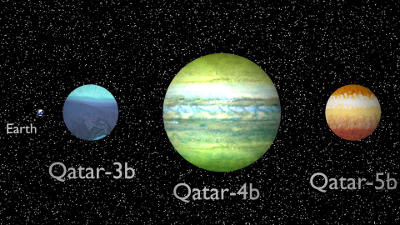Using AI to control energy for indoor agriculture
30 September 2024
Published online 7 July 2016
The Qatar Exoplanet Survey (QES) has discovered three new “exoplanets” outside our solar system.

They are located some 1400 to 1800 light years away from Earth and can be seen in the same part of the sky as the Andromeda Constellation, best observed in autumn in the northern hemisphere.
“Studying exoplanets helps add pieces to the puzzle of how our solar system was formed. Qatar-4b, for example, is one of the largest planets discovered and gives us an idea of how large planets can be,” says astronomer Khalid Alsubai, the acting executive director of the Qatar Environment and Energy Research Institute (QEERI), under the umbrella of which the QES is being done.
The QES group discovered Qatar-1b and Qatar-2b in 2010 and 2012.
With this discovery, the group found the fifth most exoplanets from among 30 teams around the world using ground-based telescopes. Currently, more than 3,000 exoplanets are known.
The three newly-discovered planets orbit around three separate stars with very short orbiting times. It only takes Qatar-3b, Qatar-4b and Qatar-5b 2.5, 1.8 and 2.9 days respectively to circle their suns. Qatar-3b and -5b are relatively similar in their masses and radii: about 4 and 1.1 times that of Jupiter. Qatar-4b is even larger, with a mass and a radius 5.9 and 1.6 times that of the largest planet in our solar system.
The QES identifies new planets using tens of thousands of images collected by their telescopes in New Mexico (US), Tenerife (Spain) and Urumqi (China). Each site has eight telescopes and their locations allow the team to observe the sky over a 24-hour period.
“The data is remotely controlled from our institute in Qatar and is collected from the three sites and processed in Qatar,” explains Alsubai.
To find planets, the researchers scan large parts of the sky on a daily basis, measuring differences in light intensity over time, known as “discovery photometry”. When they observe a “transit signal” – a 1% reduction in the brightness of a star – they investigate to determine if an orbiting planet passing in front of the star caused the signal. An exoplanet is assumed if the signal is regularly repeated, representing how long it takes for the planet to orbit the star.
This process involves using “spectroscopic observations”, which allows for a detailed study of the electromagnetic spectrum radiating from stars. It allows the team to check for other astrophysical phenomena that produce periodic signals similar to an exoplanet.
The team collected discovery photometry data from the three stars from the autumn of 2012 until the end of 2014.
Their spectroscopic observations were conducted over a period of several months until the end of 2015/beginning of 2016. Interestingly, the electromagnetic spectrum of the sun around which Qatar-5b orbits revealed it was among the most metal-rich stars known to host a planet.
“We are the only institute in the Arab and Islamic worlds doing this kind of research,” says Alsubai.
“The work is pioneering in the region because the group succeeded in building, operating and maintaining their own observational network of robotic telescopes, placed them where observational conditions are optimal, developed their own data analysis software, and the whole system proved to produce quality observations and data that allowed the group to successfully make positive detections of exoplanets,” says Alaa Ibrahim, director of the astronomical observatory at Egypt’s Zewail City of Science and Technology.
Although there are no similar projects requiring megafunding in the region, Ibrahim says there is huge potential in using publicly available data, such as that from the NASA Kepler mission, he says.
Three of Ibrahim’s students at Zewail City are developing and enhancing a software tool to process and filter Kepler mission data to search for exoplanets. “The QES discovery is a further inspiration and motivation to young researchers in the region,” he says.
“Our team’s success comes from having good team members and professional international collaborators,” says Alsubai. This latest discovery was in collaboration with institutions in the US, the UK, Germany, Italy, Denmark and Sweden.
Their latest discovery was published in the June 2016 issue of Monthly Notices of the Royal Astronomical Society.
doi:10.1038/nmiddleeast.2016.105
Stay connected: